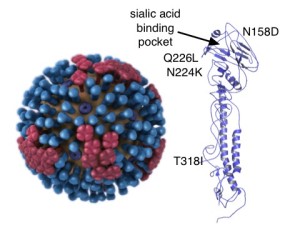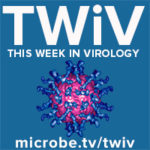 Hosts: Vincent Racaniello, Rich Condit, Alan Dove, and Michael J. Imperiale
Hosts: Vincent Racaniello, Rich Condit, Alan Dove, and Michael J. Imperiale
Michael joins the TWiV crew to discuss the recently published influenza H5N1 transmission paper and how it was viewed by the NSABB.
Click the arrow above to play, or right-click to download TWiV 182 (77 MB .mp3, 107 minutes).
Subscribe (free): iTunes, RSS, email
Links for this episode:
- About the NSABB
- The Kawaoka paper (Nature)
- Mutant flu paper published (Ed Yong)
- Osterholm letter (pdf)
- US policy for dual research of concern (pdf)
- TWiV on Facebook
- Letters read on TWiV 182
Weekly Science Picks
Alan – 18th century shipping mapped
Rich – Brave New World by Aldous Huxley
Vincent – Air France 447 (Telegraph)
Listener Pick of the Week
Josh – Vaccines course by Dr. Paul Offit
Send your virology questions and comments to twiv@microbe.tv.


With this paper and the Dutch one we now know that H5 influenza viruses can become transmissible between mammals in the lab but can we say how easy it would be to achieve this in the wild? From what I can tell the two groups had to put these viruses through intense mutation/selection. But maybe this is really nothing in comparison to the mutation rate of these RNA viruses in birds.
it didn’t happen so far. (except N158D)
And there is not much reason to do so in birds.
Maybe after xxyy passages in humans …
And then they added the reassortment, they
didn’t test it without the reassortment
(or at least they don’t write about it)
4 mutations is still quite a lot. Compare with the one mutation
that is needed for Tamiflu-resistance. It happens maybe in 20%
of treated cases. 20%^4 = 1 out of 625 , if we could construct a chain
such that each one added mutation gives an advantage
The latest podcast really failed to address the similarities between all three H5N1 transmission studies, and the fact that the Rubin Donis (CDC) paper had already been published in full (in Virology). Thus, one recipe was already public, and it was well known that Fouchier started with three changes (all of which were in the Virology published paper) and pasaage in ferrets led to the selection of the other two. Thus, the claim that publication of an unredacted paper would delay nefarious applications really had no basis in fact (passage and selection in ferrets is not a new concept or technique). The Kawaoaka paper (which also used selection in ferrets) is now public, and it is relarkably similar to the Domis and Fouchier papers, so once again the votes of the 6 NSABB members against publication of an unredacted Fouchier paper has no really science (or facts) to justify such a vote.
Moreover, claims that none of the changes other than N158D were in circulation after 2003 is false. N224K has been found in H5N1 in Egypt and Vietnam. while T318T has been found in H5N1 in China. (and the aboltion of the position 158 glycosylation has been found in all but one, out of more than 100, clade 2.2 human cases).
http://www.recombinomics.com/News/04171202/H5N1_Transmission_Egypt.html